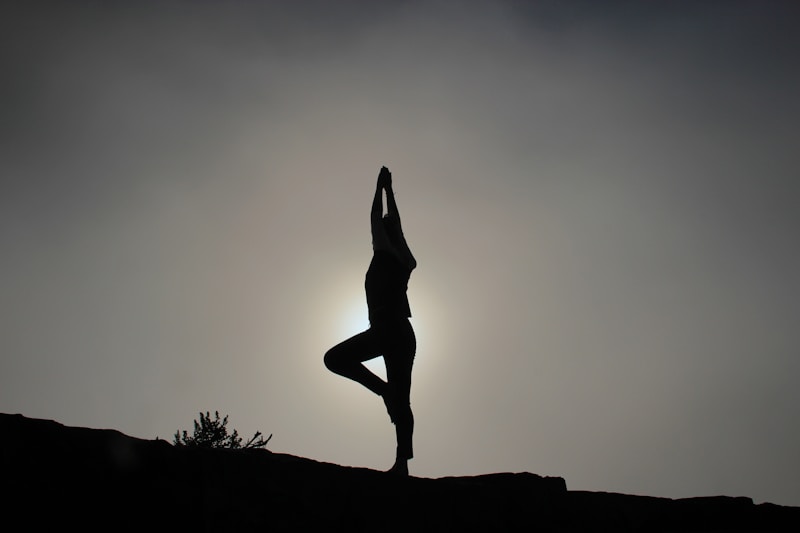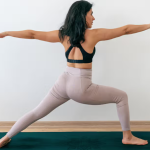I recently treated myself to the phenomenal global bestseller, The Life-Changing Magic of Tidying, written by Japan’s expert declutterer, Marie Kondo.
Within minutes of starting to read it, I leapt up and had every single item of clothing in a shockingly large pile on the bed. Three bin bags later, my wardrobe was looking fabulously empty and organised. Consequently, this has been a very hard article to write, because every time I sat down to research the piece, I found myself sorting out yet another area of my home.
Included in my epic clear-out were some dearly-loved old yoga clothes that I’d had from the beginning of my yoga journey. Like a talisman representing the epic scale of my journey, they were well-worn from hours on my mat. A grey pair of cotton leggings, they were paper thin, had a hole in the knee, and a little darned patch where a moth had nibbled a hole.
I hadn’t been able to part with them, and kept them just to wear at home, but Kondo discourages this. What she suggests is that we acknowledge all the hard work our things have done for us, and then, we feel able to let them go. True to the KonMari method, I earnestly thanked my knackered leggings, and put them ceremoniously in the bin. It worked.
This clothes-cleanse got me thinking about how this radical tidying method could be applied to all areas of yogic life. So, here are five ways the KonMari Method (named after the first halves of the author’s name, spliced together) can be applied to your yoga practice.
1. Actual Yoga Stuff
Considering the Yogic principle or Yama of Aparigraha, which means non-hoarding, it is ironic that yogis can and often accumulate a vast collection of yoga stuff. This is despite the statement by B. K. S. Iyengar in Light on Yoga that: ‘The yogi reduces his physical needs to the minimum, believing that if he gathers things he does not really need, he is a thief.’
There’s the leggings, tops, under-layers, over-layers, yogic wraps, equipment, books and the accompanying yoga ephemera such as mala beads, incense burners, yoga coasters, scarves and so on.
We invest in these things as a way of believing that they will somehow make us better at yoga, or turn us into more of a serious practitioner. But in the end, the only thing that makes us better at yoga is practice, and in order to practice, we need very little:
- 1 mat
- comfortable, non-loose clothes
Kondo encourages us to really free up our yoga practice by simplifying our possessions down to the bare, joyful essentials, and in that way, bring ourselves back to the purity of the yoga itself.
2. Discarding the Past
Kondo emphatically states that to order the world around us, ‘discarding must come first’.
Are there habits in your yoga practice that you can get rid of? Are there things that have gone way past their sell-by date, but that you cling on to because they’re familiar and comforting?
For example, I have got into a habit of starting my yoga practice by folding down onto the mat into child pose. This is a calming way to start a yoga practice. However, recently I’ve realised that I’ve stopped doing my standing poses as much as I used to. These are the basic building blocks of our yoga practice, and if we stop doing standing poses, we lose the strength in our legs, as well as endurance. If I started with Tadasana then there would be a more natural transition to standing poses.
Also, especially in forms of yoga that use props, it is easy to get into the habit of taking the prop offered, be it a belt for gomukhasana, (cow-face pose) or two bricks for Uttanasana (standing forward fold). But if we always take the props, then in a way, we are blocking our progress. Try ‘discarding’ the prop next time and just see what happens.
3. Keep Only Things that Spark Joy
Once you become a yoga teacher or start on the path to becoming a yoga teacher, it is very easy to lose that spark of joy that yoga brought you. Your practice can become habitual, formulaic, and focus all on lesson planning and sequencing.
Kondo’s tidying method requires that you physically hold your possessions in your hands, and only then decide if it sparks joy in you or not. This can also apply to our yoga practice. When you’re on the mat, are you really in touch with your body? Are you inhabiting the pose, or is your body going through the motions, while your mind remains elsewhere?
Joyfulness comes from being fully engaged with the unlimited bliss available to us at any given time, which reflects the Niyama, Santosha – contentment. Rather than worry about spending a certain amount of time on the mat, or ripping through a long list of yoga poses, simplify your practice down to just a few poses and only move on to the next one once you’ve connected to the essence of each pose.
4. Choosing What to Keep, not what to Give Up
A breakthrough moment for the author came when she realised that ruthlessly getting rid of things is not the answer. What she needed to focus on was what she wanted to keep.
The same can apply when it comes to yoga.
In the West we put a lot of pressure on ourselves to give things up – alcohol, sugar, smoking and so on. But perhaps this constant attention on what we shouldn’t be doing acts as a distraction, and we can spin the perspective to what we should be doing.
What can we take up more of in order to feel healthier, stronger and lighter? If, every time we are faced with a good and not so good choice, we think to ourselves, which one would make me feel better – in the long term? In this way, we can choose to keep the parts of our yoga practice that really bring joy. And then feel completely happy to let the rest go.
5. Cherish Who You Are now
There is a strict order to the KonMari Method to achieve long-lasting tidiness. The last thing on the list is photographs. This is because they represent our memories and are the hardest thing to part with.
But Kondo has a very convincing argument encouraging us to get rid of most of our photographs too. “It is not our memories but the person we have become because of those past experiences that we should treasure.”
Similarly, in yoga. Perhaps we used to be thinner, fitter, or able to do an advanced pose that we can no longer even attempt. Perhaps we look forward to a time when we will be able to do a free-standing handstand or get into padmasana (lotus pose) without feeling our hips creak.
Kondo reminds us that both sentiments are unhelpful: ‘We live in the present. No matter how wonderful things used to be, we cannot live in the past. The joy and excitement we feel here and now is more important.’ By freeing ourselves from the possessions we no longer really need, we allow our minds to focus on what we love. And through that, rediscover the joy and freedom of the yoga we are practising right here, right now.













